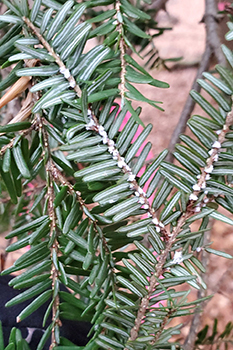
Hemlock woolly adelgids, tiny invasive insects that suck nutrients from hemlock trees, have been found in Allegan, Ottawa, Muskegon, Oceana and Mason counties.
State agency staff, university researchers and regional cooperative invasive species management areas have been working to identify and contain infestations that span across public and private lands.
These insects are considered invasive because they are not native to the state and can cause significant harm to Michigan’s hemlock resource, estimated at 170 million trees. If untreated, hemlock woolly adelgids can kill hemlock trees in four to 10 years. Trees can be protected with proper insecticide treatments.
If you have eastern hemlock trees on your property, or are just spending time outdoors this winter, we encourage you to take time to inspect these trees for signs of hemlock woolly adelgid.
Winter is the optimum time to look for evidence of an infestation because cooler temperatures trigger feeding activity, and as hemlock woolly adelgids feed, they secrete a white, waxy material that creates ovisacs. These small, round, white masses make it possible to identify infested trees.
Look on the undersides of branches for evidence of round, white ovisacs near the base of the needles. Up close, ovisacs look like balls of spun cotton and may appear alone or in clusters. The short video “Hemlock woolly adelgid: Invasive species in Michigan” provides helpful identification tips.
Report infested hemlock trees through the Midwest Invasive Species Information Network, available online at MISIN.MSU.edu or as a downloadable smartphone app. The MISIN smartphone app will take a GPS location point if a report is made at the site; it also will allow you to upload photos with a report.
Reports also can be made by email to MDA-Info@Michigan.gov or by phone to the Michigan Department of Agriculture and Rural Development Customer Service Center at 800-292-3939.
For more information on identification, reporting or treatment, visit the Michigan Invasive Species Program’s hemlock woolly adelgid page at Michigan.gov/HWA.
|